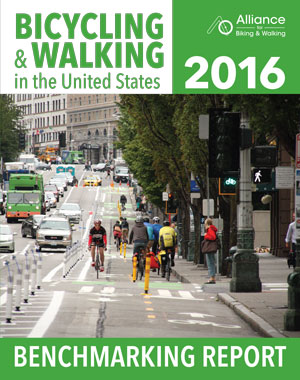 The broad trend is clear: Walking and biking are on the rise across the United States. Active transportation has broken through into the mainstream conversation and been embraced by powerful stakeholders.
The broad trend is clear: Walking and biking are on the rise across the United States. Active transportation has broken through into the mainstream conversation and been embraced by powerful stakeholders.
But the real story is far more complex than a single trend line — or simple narrative.
Our transportation choices are significantly impacted by a wealth of different factors — from gender to income to available infrastructure — and a new report from the Alliance for Biking & Walking illuminates the key indicators that shape American mobility.
Bicycling and Walking in the United States: 2016 Benchmarking Report collects and analyzes data from all 50 states, the 50 most populous U.S. cities, and 18 additional cities of various sizes. It traces the rise of walking and biking and explores the intersections between transportation, health, economics, equity, government funding, advocacy efforts — and much more.
Download the 2016 Benchmarking Report here
Analyzing data from public agencies and original research, the Benchmarking Report considers important questions such as:
- In which states and cities do the most – and fewest – people bike and walk to work?
- Where are gender gaps in bicycle commuting most – and least – pronounced?
- Which states and large cities are facing the biggest disparities in health?
- What are states and cities doing to encourage more biking and walking?
- Where are people who walk and bike killed at the highest — and lowest — rates? Which populations are disproportionately represented in these fatalities?
- What are recent studies discovering about the connections between walking and biking and health, safety, economic benefits, access to safe facilities, policy priorities and more?
- Where do cities and states find funding for bike/ped improvements?
- What types of initiatives are most common within the bike/walk advocacy movement?
Featuring dozens of engaging graphics and including insight from more than 150 studies, the Benchmarking Report is a springboard for further analysis, comparisons and storytelling. By sharing a wealth of data, the report is a catalyst for media, advocates, professionals and elected officials to understand the factors that influence bicycling and walking; identify how they stack up to other states or cities; and ask critical questions that can better chart a course to effective, equitable and healthy transportation systems in communities across the country.
Explore 9 Essential Intersections in Active Transportation
from the 2016 Benchmarking Report!
“So much invaluable information is veiled in bureaucracy, hidden in plain sight in tables and spreadsheets and databases that are difficult even for experts to discern,” said Christy Kwan, interim Executive Director of the Alliance. “The Benchmarking Report pulls together a wealth of government data and adds to our arsenal with direct city surveys — information that isn’t available anywhere else. But we don’t stop there. We make sense of those numbers in a way that is accessible, engaging and actionable for the growing number of stakeholders in the effort for safe, healthy and equitable mobility options for all.”
“The Benchmarking Report provides the numbers and analysis needed to help users and stakeholders make informed decisions about community mobility,” said Naomi Doerner, Alliance Member Services Director. “Each edition has helped to paint a clearer picture of where communities are, what is needed, and the 2016 Benchmarking Report — with the addition of equity-based metrics — provides an even sharper focus for communities to frame goals and measure progress.”
Pull back the veil on walking and biking in your city or state — download the 2016 Benchmarking Report today. And join the conversation on Twitter using #BikeWalk16 and #bikewalkequity.
Bicycling and Walking in the United States: 2016 Benchmarking Report was funded in part by the Centers for Disease Control and Prevention and AARP.

